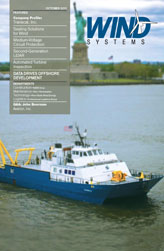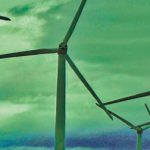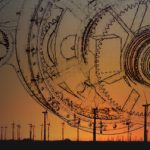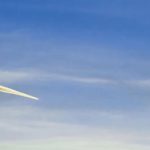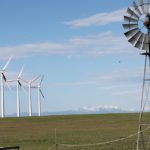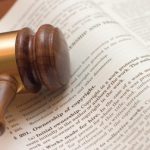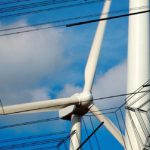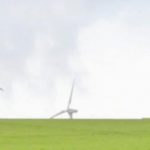Wind energy off U.S. coastlines holds enormous promise. The U.S. Department of Energy estimates offshore wind capacity—generated in the Pacific, Hawaiian Islands, Gulf, Atlantic, and Great Lakes regions—at 4,150GW. While this projection represents total gross resource potential that doesn’t account for exclusion zones or siting issues, it is four times the current generating capacity of the U.S. electric power system’s 1,028GW. Beyond production capacity offshore wind has proximity value. With the 28 Great Lakes and coastal states in the continental U.S. consuming more than 75 percent of the country’s electricity, offshore wind would significantly reduce transmission costs based on adjacency to high-electricity demand centers.
However, the promise of offshore wind generated along our vast coastline is just that, for the U.S. has yet to place a single commercial turbine in the water. Public opposition aside, conflicting state and federal regulatory guidelines and immature permitting processes have slowed efforts to build the nation’s first offshore farm. These complexities, combined with the lack of a federal Renewable Energy Standard and long-term production tax credits, discourage much-needed investment.
Still, the untapped bounty is hard to ignore. The East Coast, particularly, has attracted the attention of developers who’ve pushed forward with permitting and related development phase efforts including marine surveys, wind resource characterization, power-purchase agreement (PPA) negotiations, leasing, and financing. For example, Cape Wind recently received its final permit after a decade-long slow boil, though it still faces financing and legal challenges, while Fishermen’s Energy projects off the New Jersey coast and Deepwater Wind projects off Rhode Island continue to make headway. Fishermen’s has in place all its N.J. state permits for its demonstration project in state waters and is awaiting approval from the New Jersey Board of Public Utilities of its OREC (offshore renewable energy certificate) application, while Deepwater has negotiated the PPA for its Block Island demo site and is conducting survey studies so it can obtain its permits.
The multi-layered issues that have slowed offshore efforts, particularly the Cape Wind project, have catalyzed federal and state agencies to shorten the development phase. One stated objective of recent initiatives announced by the DOE and Department of the Interior (DOI) is to streamline permitting processes, which they acknowledge are overly complicated. Not only are these processes untested by project stakeholders, including permitting bodies themselves, they suffer from a lack of baseline site data. While project development with its various permitting stages accounts for a small percentage of offshore wind’s estimated total lifecycle costs, these efforts have thus far consumed an inordinate amount of time and resources, and with the vast majority of ongoing work still in the development phase, it’s where project efficiency efforts should currently focus (see Figure 1).
“Offshore oil projects get permits in less than two years, but the offshore wind permitting process has so far taken up to nine years,” says Paul Williamson, director of the Maine Wind Industry Initiative, a multi-industry supply chain collaborative focused on developing the state’s wind energy resources. He cites the fact that the permitting process currently requires that developers invest in gathering survey data for an environmental impact statement (EIS) just to set up the meteorological tower or buoy to measure a proposed site’s wind resources. And then, if these resources are deemed viable, they have to conduct another EIS to pursue construction permits. “Oil developers don’t have these environmental requirements.”
Site selection and permitting takes into account a multitude of environmental, commercial, recreational, navigational, archaeological, and competing use factors. With offshore wind in its infancy there’s insufficient wind resource, seabed, and other site data to create the baseline needed to streamline future projects. As part of its Offshore Wind Innovation and Demonstration (OSWInD) initiative, DOE has stated it will work to coordinate data sets collected across a range of marine projects and create national databases for shared use by developers and other entities. But with permitting currently hampered by a shortage of this critical site data, the focus is turning to expedient data acquisition. Collecting the complex data sets required by BOEMRE (Bureau of Ocean Energy Management, Regulation, and Enforcement) in federal waters, the U.S. Army Corps of Engineers in state waters, and a range of other groups, requires a marine research team highly experienced not only in marine data acquisition, but in partnering with developers and other service providers to provide the best-quality data sets cost effectively.
As these teams increasingly collect and archive critical data across different projects, best practices for permitting and other aspects of the offshore wind development phase will emerge. With baselines in place and best practices to build on, developers, agencies, and other stakeholders will be positioned to work together to shrink project timelines, reduce costs, ease PPA negotiations, encourage investment, and spur development of the materials supply chain that will provide turbine components, foundation structures, cabling, installation ships and O&M vessels, and related elements.
A Challenging Goal
With broad estimates of more than 5,200MW of energy in first-generation offshore development underway in the Atlantic and Gulf of Mexico, developers—and the regulating agencies themselves—have seen the challenges caused by immature permitting processes and other development-centric regulations. Freshwater efforts in the Great Lakes won’t have to deal with federal regulations but will likely face their own intra-state regulatory issues. Projects in the Great Lakes include a pilot by Lake Erie Energy Development Corp. (LEEDCo), which has 20-30MW under development in Lake Erie’s Ohio waters. Through this effort stakeholders expect to gain experience with regulatory requirements and foster collaboration among permitting agencies as they move to larger project scenarios of 1,500MW up to 5,000MW. In addition, the New York Power Authority is reviewing proposals for 120-150MW of development in Lake Erie and/or Lake Ontario as part of its Great Lakes Offshore Wind (GLOW) initiative. First-generation offshore ocean efforts and projected energy output are outlined in Figure 2.
In spite of its highly publicized problems, Cape Wind offered valuable insight into development phase difficulties, driving new federal initiatives and funding to speed projects. “Cape Wind was unique, with some very well-financed opposition to getting it in the water,” says Dan Shreve, director of MAKE Consulting, a Boston-based market intelligence and advisory group focused on wind energy. “We don’t expect those particular problems to be repeated, and they also catalyzed movement to streamline development processes [for site selection and leasing].”
For example, in the aftermath of Cape Wind, DOI, as part of its Smart from the Start Initiative, instituted a program to ease site selection and leasing by creating Wind Energy Areas (WEAs). Through the program, BOEMRE identifies specific zones suitable for development based on such criteria as water depth, proximity to seacoast, and navigational hazards, and packages pre-approved leases. Thus far the agency has identified four mid-Atlantic development zones on the Outer Continental Shelf (OCS)—off Delaware, Maryland, New Jersey, and Virginia—for commercial leasing by developers and has announced it would do so for sites off Massachusetts, Rhode Island, and North Carolina. It has initiated processes for both competitive and non-competitive leasing proposals and is expected to begin the commercial leasing process as early as next year.
After a WEA bid is accepted, the developer must then seek BOEMRE approval for several consecutive phases, each of which depends on satisfactory data. Based on exclusive rights to the leased area it submits its development plan; a site assessment plan for deploying meteorological towers or buoys for wind resource characterization; and finally a construction and operations plan, to which it attaches detailed site characterization data captured through oceanographic, geotechnical, geophysical, environmental, and archaeological surveys. Figure 3
“Permitting is seen as a major impediment to offshore wind because Cape Wind had a way of coloring the entire process as inherently impossible, but that view is getting tempered through recent efforts to streamline permitting,” says Jesse Broehl, advisor at MAKE Consulting. To date, it has taken up to nine years for developers to get full permitting in part because they had to do two EISs: one to get approval for the meteorological tower or buoy, and a second to pursue construction. The DOI is moving to allow conditional use permits to install met towers without conducting a full front-end EIS, which Broehl says “should knock two to three years off the permitting process.”
The More Data the Better
Each phase of an offshore wind farm lifecycle—from development, to turbines and transmission infrastructure construction, to full operations and, finally, to decommissioning—requires an enormous amount of marine survey data. Based on hard lessons learned in oil and gas projects, and more recently offshore wind projects in Europe, developers have learned that the more data they gather, the better chance the project will meet budget projections and timeline deliverables.
Given the challenges inherent in conducting data acquisition in dynamic and unpredictable marine conditions, developers must be able to rely on experienced research teams that emphasize data quality, efficiency, and safety as they employ the latest survey techniques to meet state and federal regulatory requirements. If developers cut corners on front-end data acquisition there’s a good chance they’ll suffer consequences down the road, as experience in gas and oil development has proven. While data acquisition accounts for a small percentage of overall wind project costs, an effort that is properly funded and thoroughly and efficiently conducted quickly pays for itself. Moreover, comprehensive data sets deliver exponentially larger financial benefits because they can, for example, prevent the need to remobilize personnel, vessels, and related assets caused by insufficient data for permitting and other requirements. In other words sound, sufficient data collection is relatively cheap insurance for protecting stakeholder investments.
For research teams to fully exploit their collective experience to gather the best possible data sets, they require a platform with state-of-the-art survey and deployment equipment, hardware, and software technologies. Though teams might be able to lease research vessels from universities or temporarily retrofit other-use vessels for survey activity, these approaches can negatively affect costs and efficiency. University research vessels, for example, are typically booked for university projects and therefore aren’t readily available for commercial work. And commercial research vessels already working in the Gulf on oil and gas projects might not have the financial incentive to leave the area, where they can currently charge up to a third more than they can for wind projects off the East Coast.
The best possible scenario is to hire coordinated data acquisition teams experienced in wind energy projects and get them onboard a dedicated survey research vessel, optimally one on which they’ve already worked gathering multiple-use data. The conditions in which these vessels must operate demand strong seakeeping in both shallow and deeper waters, superior positioning capabilities, line-keeping performance, and ideally a propulsion system that provides tight maneuverability with little noise disturbance. For surveying activity the vessel should be outfitted with dedicated cranes and winches, and incorporate progressive design modifications that enable numerous approaches to equipment deployment for geotechnical, geophysical, environmental, hydrographic, archaeological, and oceanographic surveys.
To maximize project efficiencies, research vessels should also be equipped for extended periods at sea—providing overnight accommodations, freshwater and fuel reserves, and onboard laboratories—to mitigate the costs and time incurred when traveling between a port and study sites. A laboratory with onboard data processing is particularly advantageous, as it allows for realtime data assessment. Onboard data analysis is a cost and efficiency differentiator for any offshore project, since it allows research teams to determine if a survey design needs to be modified while they’re already mobilized; for example, if survey data reveals that a cable route should be remapped. If teams demobilize and then determine through subsequent data analysis that they need to modify designs, they face a costly remobilization effort.
Don’t Reinvent the Wheelhouse
As part of the OSWInD initiative, DOE is working with DOI to coordinate efforts to help offshore projects deliver a targeted 54GW of offshore wind generating capacity by 2030, at a cost of $0.07 per kWh. It’s an ambitious goal given progress to date and the challenges involved. Agencies, developers, and other stakeholders must collaborate to shrink development stages to get projects into operation, or they can’t prove that offshore wind energy can be delivered at competitive price points.
The agencies’ joint National Offshore Wind Strategy plan includes an initial $50.5 million to fund proposals that encourage development of wind assets by improving technology and removing market barriers—including the lack of baseline marine and wind resource data—that drive up costs. And as part of Smart from the Start, BOEMRE recently announced that it is preparing a draft environmental assessment (EA) to gather public and other stakeholder comment on environmental impact before issuing commercial leases for potential WEAs. These EAs, according to BOEMRE, can potentially streamline efforts by helping agencies determine whether more comprehensive EISs are required before projects can move forward with preliminary wind resource characterization.
Stakeholders should also leverage lessons learned in offshore oil and gas projects and European wind installations to gather marine data in the most efficient, cost-effective ways possible. Reinventing data collection processes for U.S. offshore wind projects is cost-prohibitive and wasteful when best practices from oil and gas sectors and existing wind installations can be adapted.
The offshore wind industry benefits from a mindset that combines engineering and environmental innovation to drive next-generation energy technologies and production. While immaturity in the U.S. market has slowed projects, development efforts continue, delivering survey data necessary for wind characterization, turbine design, cable transmission routes, air and sea navigation, environmental impact, and a multitude of related assessments. Comprehensive national databases built from these studies will help provide the information needed to design an offshore infrastructure capable of cost-effectively delivering the output the U.S. requires to create a sustainable energy portfolio.



















